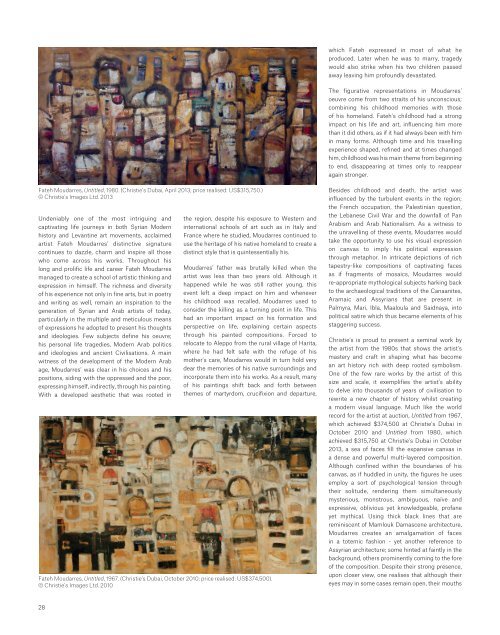NOW AND TEN
DUB1241_SaleCat
DUB1241_SaleCat
You also want an ePaper? Increase the reach of your titles
YUMPU automatically turns print PDFs into web optimized ePapers that Google loves.
which Fateh expressed in most of what he<br />
produced. Later when he was to marry, tragedy<br />
would also strike when his two children passed<br />
away leaving him profoundly devastated.<br />
The fgurative representations in Moudarres’<br />
oeuvre come from two straits of his unconscious;<br />
combining his childhood memories with those<br />
of his homeland. Fateh’s childhood had a strong<br />
impact on his life and art, infuencing him more<br />
than it did others, as if it had always been with him<br />
in many forms. Although time and his travelling<br />
experience shaped, refned and at times changed<br />
him, childhood was his main theme from beginning<br />
to end, disappearing at times only to reappear<br />
again stronger.<br />
Fateh Moudarres, Untitled, 1980. (Christie’s Dubai, April 2013; price realised: US$315,750.)<br />
© Christie’s Images Ltd. 2013<br />
Undeniably one of the most intriguing and<br />
captivating life journeys in both Syrian Modern<br />
history and Levantine art movements, acclaimed<br />
artist Fateh Moudarres’ distinctive signature<br />
continues to dazzle, charm and inspire all those<br />
who come across his works. Throughout his<br />
long and prolifc life and career Fateh Moudarres<br />
managed to create a school of artistic thinking and<br />
expression in himself. The richness and diversity<br />
of his experience not only in fne arts, but in poetry<br />
and writing as well, remain an inspiration to the<br />
generation of Syrian and Arab artists of today,<br />
particularly in the multiple and meticulous means<br />
of expressions he adopted to present his thoughts<br />
and ideologies. Few subjects defne his oeuvre;<br />
his personal life tragedies, Modern Arab politics<br />
and ideologies and ancient Civilisations. A main<br />
witness of the development of the Modern Arab<br />
age, Moudarres’ was clear in his choices and his<br />
positions, siding with the oppressed and the poor,<br />
expressing himself, indirectly, through his painting.<br />
With a developed aesthetic that was rooted in<br />
the region, despite his exposure to Western and<br />
international schools of art such as in Italy and<br />
France where he studied, Moudarres continued to<br />
use the heritage of his native homeland to create a<br />
distinct style that is quintessentially his.<br />
Moudarres’ father was brutally killed when the<br />
artist was less than two years old. Although it<br />
happened while he was still rather young, this<br />
event left a deep impact on him and whenever<br />
his childhood was recalled, Moudarres used to<br />
consider the killing as a turning point in life. This<br />
had an important impact on his formation and<br />
perspective on life, explaining certain aspects<br />
through his painted compositions. Forced to<br />
relocate to Aleppo from the rural village of Harita,<br />
where he had felt safe with the refuge of his<br />
mother’s care, Moudarres would in turn hold very<br />
dear the memories of his native surroundings and<br />
incorporate them into his works. As a result, many<br />
of his paintings shift back and forth between<br />
themes of martyrdom, crucifxion and departure,<br />
Fateh Moudarres, Untitled, 1967. (Christie’s Dubai, October 2010; price realised: US$374,500).<br />
© Christie’s Images Ltd. 2010<br />
Besides childhood and death, the artist was<br />
infuenced by the turbulent events in the region;<br />
the French occupation, the Palestinian question,<br />
the Lebanese Civil War and the downfall of Pan<br />
Arabism and Arab Nationalism. As a witness to<br />
the unravelling of these events, Moudarres would<br />
take the opportunity to use his visual expression<br />
on canvas to imply his political expression<br />
through metaphor. In intricate depictions of rich<br />
tapestry-like compositions of captivating faces<br />
as if fragments of mosaics, Moudarres would<br />
re-appropriate mythological subjects harking back<br />
to the archaeological traditions of the Canaanites,<br />
Aramaic and Assyrians that are present in<br />
Palmyra, Mari, Ibla, Maaloula and Saidnaya, into<br />
political satire which thus became elements of his<br />
staggering success.<br />
Christie’s is proud to present a seminal work by<br />
the artist from the 1980s that shows the artist’s<br />
mastery and craft in shaping what has become<br />
an art history rich with deep rooted symbolism.<br />
One of the few rare works by the artist of this<br />
size and scale, it exemplifes the artist’s ability<br />
to delve into thousands of years of civilisation to<br />
rewrite a new chapter of history whilst creating<br />
a modern visual language. Much like the world<br />
record for the artist at auction, Untitled from 1967,<br />
which achieved $374,500 at Christie’s Dubai in<br />
October 2010 and Untitled from 1980, which<br />
achieved $315,750 at Christie’s Dubai in October<br />
2013, a sea of faces fll the expansive canvas in<br />
a dense and powerful multi-layered composition.<br />
Although confned within the boundaries of his<br />
canvas, as if huddled in unity, the fgures he uses<br />
employ a sort of psychological tension through<br />
their solitude, rendering them simultaneously<br />
mysterious, monstrous, ambiguous, naïve and<br />
expressive, oblivious yet knowledgeable, profane<br />
yet mythical. Using thick black lines that are<br />
reminiscent of Mamlouk Damascene architecture,<br />
Moudarres creates an amalgamation of faces<br />
in a totemic fashion - yet another reference to<br />
Assyrian architecture; some hinted at faintly in the<br />
background, others prominently coming to the fore<br />
of the composition. Despite their strong presence,<br />
upon closer view, one realises that although their<br />
eyes may in some cases remain open, their mouths<br />
28


